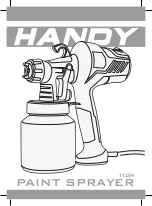
2
7
Operating Instructions and Suggestions
This portable touch-up gun offers a highly controlled spray pattern for pinpoint
accuracy, reducing wasted gel coat and harmful emissions. Its small size,
minimal air consumption, and easy clean-up makes it the perfect choice for
on-site repairs.
This gun comes fitted with a 2.0mm nozzle, which is ideal for any of our gel
coats. But don’t use it just for repairs; it’s also great for spraying PVA! Ships
complete with 1/4 pint cup, cleaning brush, and 1 mini filter.
Read this Instruction Manual carefully. Basic precautions should be strictly
followed to prevent the damage to the tool and injury to the operator. Retain
this manual for further reference.
Important Safety Instructions:
1.
Certain materials can create toxic vapors, intoxication and serious
damage to health. Always wear safety glasses, gloves and respirator
to prevent the toxic vapor hazard, or solvent and gel coat coming into
contact with your eyes or skin.
2.
Never use oxygen, combustible or any other bottle gas as a power
source to avoid explosion and serious personal injury.
3.
Fluid and solvent can be highly flammable or combustible. Use in
well-ventilated spray booth and avoid any ignition sources, such as
smoking, open flames and sparks.
4.
Disconnect tool from air supply when not in use or maintaining also a
shut off valve. As an emergency stop is recommend.
5.
Use clean, dry and regulated compressed air rated at 30 - 80 PSI. Never
exceed maximum permissive operating pressure.
6.
Never use homogenate hydrocarbon solvent, which can chemically
react with aluminum and zinc parts and chemically compatible with
aluminum and zinc parts.
7.
Never point gun at you or others at any time.
8.
Before operating the tool, make sure all the screws & caps are securely
tightened in case of leaking.
9.
Before spraying, be sure the trigger and related parts operate smoothly.
10.
Never modify this tool for any applications. Only use recommended
parts, nozzles and accessories.
GEL COAT TROUBLESHOOTING GUIDE
Proper gel coat application is difficult for professionals and is probably the
most common problem area for those new to fiberglass work. Most common
gel coat problems are related to temperature variation, catalyzation and a
variety of handling techniques. The following list of gel coat problems and
causes should help to resolve some of the difficulties associated with gel coat.
1. Wrinkles And Pinholes: A coating less than five mils thick may wrinkle,
especially when brush marks are present. Check the thickness using a gel coat
thickness gauge. The preferred thickness is .010” to .020”.
A wrinkle can also occur if the gel coat is not cured enough prior to lay-up.
Before lay-up check the surface for tack. The surface should be sticky but not
transfer to your finger. Several things can affect a slow cure; solvent or water
entrapment, under catalyzation, cold temperatures and other factors.
If the gel coat film contains pinholes, check the spray equipment for moisture
in the air lines or dirt in the traps. It is also important to review your spray
techniques.
2. Slow Gel Coat Cure: Any temperature below 70 degrees F will retard the gel
time. An under-catalyzed gel coat will also result in a slow cure but this is not a
recommended technique for deliberately lengthening gel time. High moisture
and humidity will lengthen the gel time.
3. Sagging Of The Gel Coat: The most common reasons for gel coat sags would
be when the gel coat is applied in an excessively heavy application in one or
more passes.
To avoid sagging, spray in multiple light coats at a 15” distance from the mold.
The maximum thickness to be sprayed at one application is .016”.
4. Porosity: Gel coat porosity (air bubbles) is normally caused by trapped air
or moisture. This can be prevented by limiting the spray thickness per pass to
.005”. It is also important to verify that the proper air pressure is being used
because an over pressurized spray can cause fine porosity. Air pressure should
be set at 30 - 80 PSI, depending on viscosity.
5. Separation Of Color: Most color separations are related to improper spray
techniques. Reduce or lower thinning agents and lower the per pass thickness
of the gel coat. It is also important to avoid any spray overlap areas.

























